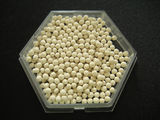Molecular sieve
Molecular sieves are a type of material with very small holes of precise and uniform size. These holes are small enough to block large molecules, while allowing small molecules to pass. Although the term also encompasses silica gel and activated charcoal, this article will focus on the classic zeolite spherical beads.
Contents
Properties
Physical
Molecular sieves are generally white to off-white spheres, though they also come in the form of cylinders, of various sizes, though the most common type has a diameter or 2-3 mm. They are made of various materials, such as zeolite, or natural/synthetic clays. The size of the sieves is measured in Angstroms (Å). They will absorb water and other fluids from various liquids or air. This process is reversible.
Chemical
Molecular sieves have no reactivity towards common solvents, but they will react with corrosive chemicals such as a acids.
Molecular sieves are incompatible with a variety of solvents, like ketones (acetone, butanone, etc.), as it causes aldol condensation of the ketone.
Availability
Molecular sieves are sold by many chemical suppliers, as well as many industrial products sellers. Ebay is a good place to start.
Sometimes they can also be found inside the caps of certain medical drug tubes.
A low grade form of molecular sieves can be acquired from fridge filter driers. These beads require desorption in order to remove the water content, as well as washing them with an organic solvent to remove any traces of oil that tends to contaminate the drying column. If the driers come from an old fridge, they may contain freons, and purifying the sieves becomes complicated, as freons are toxic.
Sieves from second-hand sources tend to be of lower quality than those from big companies, as noted by NurdRage.[1]
Projects
- Dry solvents
- Purify gas streams
- Reactor catalyst
Handling
Safety
Molecular sieves pose little toxicity as they're made of zeolite, which are also found in nature. If they have adsorbed any toxic gasses, such as freons, they may pose health problems.
Storage
In sealed bottles, just like any desiccant: away from any moisture or volatile compounds.
Disposal
They can be regenerated by heating them in a stream of fluid. Do not heat them too high, or they will crack. Most often however they are regenerated (usually after washing them with water) by heating in a strong vacuum (as low as 2 mBar) to a high temperature (up to 320 °C) - despite looking dry molecular sieves often hold a surprisingly large amount of water![2]
Gallery
References
- ↑ https://www.youtube.com/watch?v=MduzjhRHBFY
- ↑ https://www.bcp.fu-berlin.de/chemie/chemie/studium/ocpraktikum/ressourcen/laborpraxis/laborpraxis_webinfos/fluessigkeiten/absolutieren/molsiebe.html
